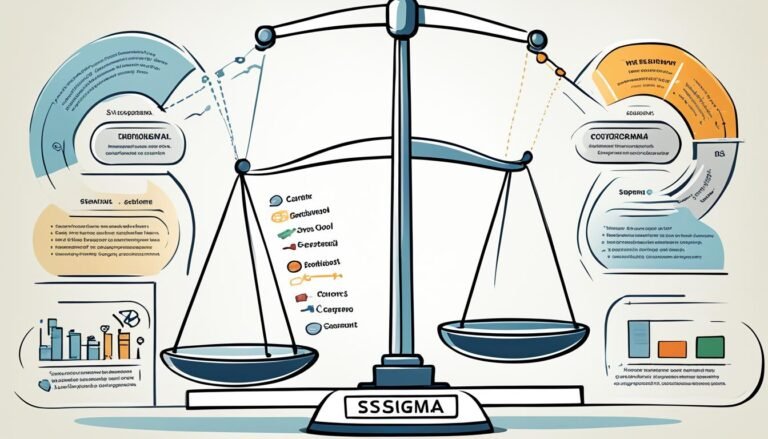Building High-Performing Virtual Teams: Strategies for Success
So, you’ve been tasked with leading a virtual team. It’s not like managing a regular team, right?
In ‘Building High-Performing Virtual Teams: Strategies for Success,’ you’ll discover practical tactics to unleash the full potential of your team. From mastering virtual communication to fostering engagement, this guide has got you covered.
You’ll explore ways to navigate time zone differences, utilize technology for seamless collaboration, and cultivate a culture of trust and accountability.
Get ready to elevate your virtual team’s performance to new heights.
Key Takeaways
- Building trust and rapport through open and transparent communication
- Utilizing effective communication strategies such as active listening and nonverbal cues
- Establishing clear goals, expectations, and accountability measures
- Leveraging technology for seamless collaboration and task management
Understanding Virtual Team Dynamics
To effectively understand virtual team dynamics, you need to recognize the unique challenges and opportunities that arise when working in a distributed environment. Building trust in remote dynamics is one of the key challenges faced by virtual teams. Without the benefit of face-to-face interactions, team members may struggle to establish rapport and trust, which are crucial for effective collaboration. To address this challenge, it’s important to encourage open and transparent communication. Remote team dynamics can be improved by utilizing video conferencing, instant messaging, and regular virtual meetings to foster a sense of connection and trust among team members.
Virtual team challenges also stem from differences in time zones, cultural norms, and communication styles. To overcome these challenges, it’s essential to establish clear communication strategies. Encouraging active participation in virtual meetings, setting norms for responsiveness to emails and messages, and providing thorough documentation of discussions and decisions can help mitigate the impact of these challenges. Additionally, utilizing technology platforms that facilitate easy sharing of information and collaboration can enhance remote team dynamics and mitigate communication barriers.
Effective Communication Strategies
When building high-performing virtual teams, you need to establish clear communication strategies to effectively address the challenges of remote dynamics and facilitate seamless collaboration. Effective communication is crucial for virtual teams to function cohesively and achieve their objectives. Here are four key strategies to enhance communication within virtual teams:
-
Active Listening: Encourage team members to actively listen to one another during virtual meetings and discussions. This involves giving full attention to the speaker, asking clarifying questions, and demonstrating understanding through verbal affirmations.
-
Nonverbal Cues: Despite the virtual nature of interactions, nonverbal cues play a significant role in communication. Encourage team members to use nonverbal cues such as nodding, maintaining eye contact, and using hand gestures to convey attentiveness and engagement.
-
Feedback Mechanisms: Implement structured feedback mechanisms to ensure that team members can provide input, share concerns, and offer suggestions. This can be achieved through regular feedback sessions, anonymous surveys, or dedicated communication channels for voicing opinions.
-
Cultural Sensitivity: Virtual teams often comprise members from diverse cultural backgrounds. It’s essential to promote cultural sensitivity and awareness within the team to avoid misunderstandings and promote inclusivity. Encourage open discussions about cultural differences and ensure that all team members feel respected and valued.
Establishing Clear Goals and Expectations
You should begin by establishing clear goals and expectations within your virtual team to ensure alignment and accountability. Setting boundaries is crucial to delineate each team member’s responsibilities and prevent misunderstandings. Clear communication is essential to convey these goals and expectations effectively. Make sure that everyone understands the performance metrics that will be used to evaluate the team’s progress. This will help create a shared understanding of what success looks like and ensure that everyone is working towards the same objectives.
In addition to setting goals, it’s important to clarify each team member’s role. Role clarity helps prevent duplication of efforts and ensures that everyone knows what’s expected of them. This can be achieved through open discussions and documentation of individual responsibilities. It’s also essential to encourage open dialogue to address any confusion or concerns regarding roles and expectations.
Regular check-ins and progress updates can help keep the team focused on the established goals and provide an opportunity to address any deviations from the plan. As the team leader, you should provide ongoing support and guidance to help team members stay on track and overcome any obstacles they may encounter.
Leveraging Technology for Collaboration
Now, let’s talk about how to leverage technology for collaboration.
Virtual collaboration tools and remote team communication are essential for ensuring that your virtual team operates smoothly and efficiently.
Virtual Collaboration Tools
Leveraging technology for collaboration requires selecting the most effective virtual collaboration tools for your team’s specific needs. When choosing the right tools, consider the following:
-
Communication Platforms: Utilize platforms that offer seamless messaging, video conferencing, and file sharing to enhance online collaboration and ensure remote work efficiency.
-
Project Management Software: Implement tools that enable task assignment, progress tracking, and deadline management, promoting virtual team productivity and effective coordination.
-
Cloud-Based Document Sharing: Use secure cloud storage solutions for real-time document collaboration, facilitating digital teamwork and improving accessibility to shared files.
-
Virtual Whiteboarding Tools: Incorporate interactive whiteboarding software to support brainstorming sessions, visual idea sharing, and collaborative problem-solving, enhancing creativity and innovation within the team.
Selecting the right virtual collaboration tools can significantly impact the success of your remote team, fostering efficient communication and productive teamwork.
Remote Team Communication
Utilize technology to facilitate seamless communication and collaboration within your remote team. To enhance remote team productivity, employ virtual team communication strategies that leverage technology effectively.
Implementing tools such as video conferencing, instant messaging, and project management platforms can streamline communication and ensure that team members stay connected. Encourage the use of collaborative document editing and file-sharing to promote real-time collaboration and information exchange.
Additionally, establish clear guidelines for communication channels and response times to maintain efficient and effective virtual interactions. Regularly scheduled virtual meetings and check-ins can help foster a sense of unity and keep everyone aligned with team goals.
Nurturing Team Engagement and Morale
Now let’s talk about nurturing team engagement and morale.
Building strong virtual team bonding and finding effective ways to motivate remote team members are crucial for maintaining high levels of engagement and morale.
Virtual Team Bonding
To foster strong connections and boost morale within your virtual team, regularly schedule interactive team-building activities and virtual social events.
Consider incorporating virtual team icebreakers and team building activities to help team members get to know each other in a relaxed setting.
Additionally, organizing remote team social events such as virtual happy hours can provide an informal platform for team members to interact and bond.
Encourage participation in online games or challenges that promote collaboration and friendly competition.
Furthermore, hosting virtual coffee chats or lunch sessions where team members can engage in casual conversations can help strengthen relationships and create a sense of camaraderie.
Remote Team Motivation
Enhance team engagement and morale by consistently recognizing and celebrating individual and team achievements.
Motivating remote teams requires understanding team dynamics and addressing time zone challenges.
Use video calls and messaging platforms to create a sense of unity and foster remote team engagement.
Encourage open communication and active participation to strengthen team dynamics.
Recognize the unique contributions of each team member, acknowledging their efforts to boost morale.
Utilize virtual team-building activities to promote collaboration and strengthen bonds.
Empower team members to take ownership of their work and provide them with opportunities for skill development.
Overcoming Time Zone Challenges
Overcoming time zone challenges requires coordinating schedules and communication effectively to ensure seamless collaboration across different locations. When working with a virtual team spread across various time zones, it’s crucial to implement strategies that promote inclusivity and productivity. Here are some key approaches to help your team overcome time zone challenges:
-
Flexible Scheduling: Encourage team members to find overlapping hours within their respective time zones for real-time collaboration. This may involve adjusting work hours or implementing flexible work arrangements to accommodate different time zones.
-
Communication Protocols: Establish clear communication protocols that outline when and how team members should communicate across different time zones. This could involve setting designated communication windows, utilizing asynchronous communication methods, and leveraging technology to facilitate seamless interaction.
-
Transparency and Clarity: Ensure that all team members have access to a centralized platform where project timelines, deadlines, and meeting schedules are clearly communicated. This transparency helps everyone stay informed and aligned, regardless of their time zone.
-
Respect for Personal Time: Encourage a culture of respect for personal time by being mindful of colleagues’ working hours. Avoid expecting immediate responses during non-overlapping hours and be considerate of time zone differences when scheduling meetings or setting deadlines.
Building Trust and Accountability
Implement five key strategies for fostering trust and accountability within your virtual team to ensure high performance and collaboration. Building trust in a virtual team is crucial for creating a cohesive and productive work environment. Start by establishing clear communication channels to encourage open and honest dialogue. This can be achieved through regular video conferences, instant messaging platforms, and email updates. Encourage team members to share their thoughts, ideas, and concerns, fostering an atmosphere of transparency and trust. Another vital aspect of trust building is to demonstrate reliability and consistency in meeting deadlines and delivering on commitments. By consistently meeting expectations, you can build trust and confidence within the team.
In terms of accountability measures, it’s essential to establish clear roles and responsibilities for each team member. This clarity helps in holding individuals accountable for their specific tasks and deliverables. Additionally, setting measurable goals and regularly tracking progress is an effective way to ensure accountability within the team. By using project management tools and software, you can monitor the progress of tasks and provide support or guidance where needed. Furthermore, promoting a culture of peer accountability within the team can also strengthen overall accountability. Encouraging team members to support and hold each other accountable can enhance the sense of responsibility and drive for results. By implementing these strategies, you can create a high-performing virtual team built on trust and accountability.
| Trust Building Strategies | Accountability Measures |
|---|---|
| Clear Communication Channels | Establishing Clear Roles and Responsibilities |
| Demonstrating Reliability and Consistency | Setting Measurable Goals and Tracking Progress |
| Encouraging Open and Honest Dialogue | Promoting a Culture of Peer Accountability |
Sustaining High Performance
You consistently sustain high performance in virtual teams by fostering a culture of continuous improvement and adaptation. In order to maintain momentum and ensure performance sustainability, consider the following strategies:
-
Regular Performance Reviews: Schedule periodic performance reviews to assess the team’s progress, identify areas for improvement, and celebrate achievements. This helps in maintaining a high level of performance and keeps the team focused on its goals.
-
Open Communication Channels: Encourage open and transparent communication within the team. This allows for the exchange of ideas, feedback, and constructive criticism, which are essential for sustaining high performance.
-
Flexibility and Adaptability: Embrace flexibility and adaptability to meet the changing demands of virtual teamwork. This includes being open to new approaches, adjusting workflows, and accommodating the diverse needs of team members.
-
Recognition and Reward: Acknowledge and reward outstanding performance to motivate team members. Recognition can take various forms, such as public praise, monetary incentives, or opportunities for professional development. This fosters a positive and productive work environment, contributing to sustained high performance.
Conclusion
In conclusion, building high-performing virtual teams requires understanding dynamics, effective communication, clear goals, technology, team engagement, time zone challenges, trust, and accountability.
Did you know that 83% of employees believe that remote work is here to stay? By implementing the strategies discussed, you can ensure the success of your virtual team and contribute to the growing trend of remote work.




